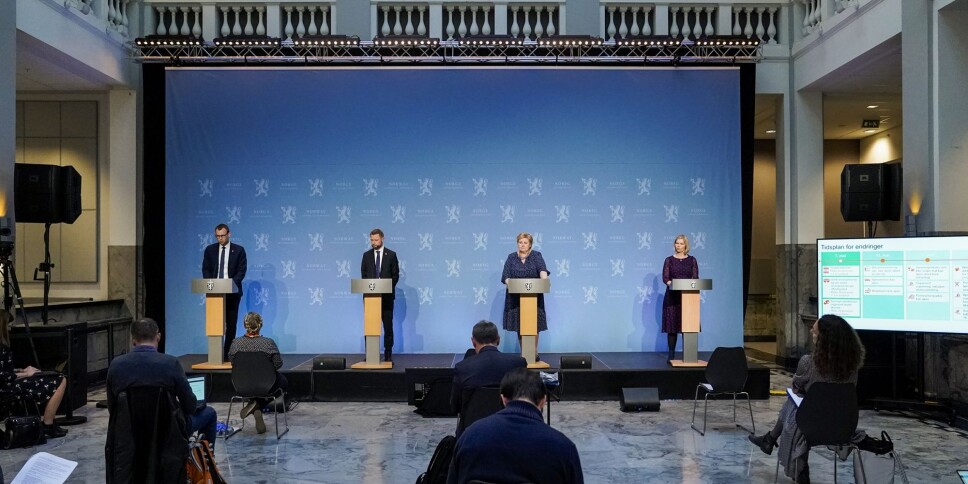This article was produced and financed by Oslo Metropolitan University - read more

How to communicate effectively during a pandemic threat
There are some common mistakes the media and health authorities make when communicating a pandemic threat, according to Professor Harald Hornmoen.
There have been a series of pandemic alarms over the past twenty years: SARS, bird flu, swine flu, Ebola, and now the ongoing COVID-19 pandemic. The media have tended to cover the possible threats in dramatic headlines, and the health authorities have presented alarming scenarios to the public.
“Communicating health risks is a very challenging task for both the media and health authorities, but it is important that they learn from their mistakes,” says Professor Harald Hornmoen of OsloMet.
Signs of improvement
Hornmoen has researched how Norway and other countries communicated the 2014–2015 Ebola outbreak and the 2009 swine flu pandemic. He found that the news reports tended to be one-dimensional and give little space for corrective perspectives. Both the media and health authorities could benefit from refining their risk and crisis communication, he concluded in his study of the communication of the swine flu in Norway.
However, a few months into the COVID-19 crisis, he has observed signs of improvement.
“The media and health authorities may have learnt a lesson or two from the previous pandemic alarms, and have therefore succeeded in improving their communication skills,” Hornmoen says.
“So far, the coverage is much better than it was for example during the swine flu reporting in 2009, the professor continues. Back then, the media provided little space for critical perspectives, and with a few exceptions in some newspapers, the articles barely included layperson perspectives. Now it seems like there has been a shift towards a more balanced way of communicating.”
Hornmoen describes numerous examples of how the Norwegian and international press have covered the coronavirus in a broader manner—elaborating on the health risks, the many consequences of societal lockdown and the uncertainty surrounding how to correctly approach the pandemic.
“Also, the mainstream media, which people tend to resort to during times of crisis, have not hesitated to be critical of the authorities. They have also given scientific experts with various opinions the chance to express their views. Take the coverage of the Swedish model of battling COVID-19, which has been very different from that in comparable countries like Norway and Denmark. News reports have portrayed the different models in both positive and negative ways,” Hornmoen explains.
The journalism professor also seeks to underscore that during times of crisis, one of the most important tasks of the media is to act a watchdog and ask difficult, critical questions to the authorities, the politicians and the experts.
Alarm-inducing headlines
During the swine flu, news headlines often played on fear and had the effect of alarming readers, according to Hornmoen's study. He explains that it can be hard for journalists to live up to the ideals of being critical towards the health authorities when the authorities’ own rhetoric legitimises dramatic headlines that help sell newspapers in a highly competitive market.
Moreover, during the swine flu, information from the health authorities was amplified in a crisis discourse, and the worst case-scenario was emphasised frequently.
“This has somewhat been true for the COVID-19-coverage, but with somewhat more sober language and a larger range of possible scenarios. The media's coverage and the messaging from the health authorities have been alarming, but not alarmist—and this represents a significant difference from previous pandemic coverage,” in Hornmoen's view.
Avoid creating a sense of panic
As for the health authorities, Hornmoen claims that it's crucial to communicate the risks and threats of the pandemic in a clear, understandable manner. A central objective is namely to get people to act appropriately towards the threat. The trick, however, is to find the right balance so that the message does not cause people to panic.
“This is challenging, especially when the health authorities have to operate with different scenarios, as they do with the COVID-19-situation. Lack of knowledge complicates the communication, and the authorities must consider carefully how to present worst-case scenarios and what the bases for these scenarios are.”
In Norway, for example, the authorities have admitted openly that there are many unanswered questions about the coronavirus and the long-term consequences of the societal lockdown.
Admitting uncertainty is a recommended strategy in a situation like this, according to Hornmoen.
“Honesty is important when communicating the unknown. It is a more trustworthy path as opposed to pretending to have all the answers when it is obvious that one doesn’t.”
Present a range of different scenarios
At the same time, the inhabitants of a country look to the authorities for guidance and answers, so it is important to communicate that the situation is at least somewhat under control. Otherwise, a chaotic situation may result.
“Demonstrate the probability that a worst case-scenario will occur, but emphasise other scenarios than worst-case,” is Professor Hornmoen's advice.
From a communications standpoint, the authorities cannot risk that when the pandemic is over, they will be blamed for not having done everything in their power to make the crisis as small as possible.
“The communication must mirror the seriousness of the situation. It must be clear to everybody that the authorities did all they could to prevent the worst-case scenarios from occurring.”
The professor’s advice
- Be up-front about gaps in knowledge and uncertainty attached to risks.
- Expose difficult choices and dilemmas authorities face.
- Consider closely how to present worst-case scenarios and what the bases for these scenarios are.
- Demonstrate the probability that a worst case-scenario will occur.
- Emphasise other scenarios than the worst-case scenario.
- Instead of a rhetoric of fear, employ more sober language.
- Avoid blaming the media and journalists for everything that goes wrong.


































